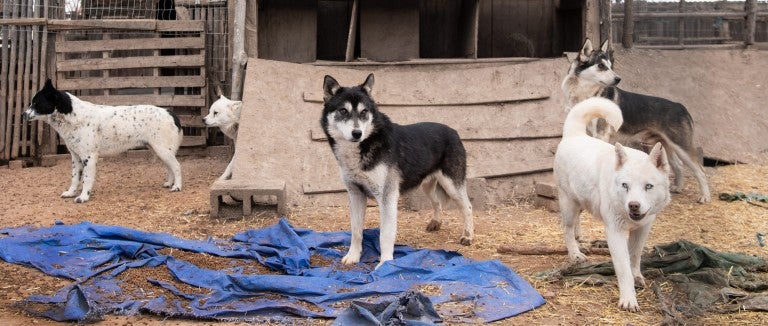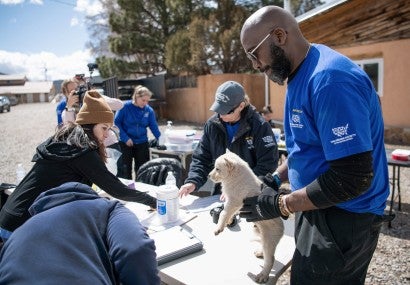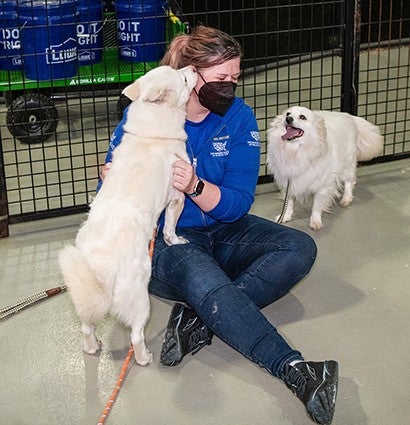Someone must have been bringing food and water to the husky mixes at the junk-strewn property just off the interstate near Las Vegas, New Mexico. But when our Animal Rescue Team arrived in March, there were only scraps of kibble on the frozen, feces-caked ground and a bowl of what looked like mud. The 62 dogs, 19 of them puppies, were hiding in holes they had dug to escape the cold and the midday desert sun. A bunch huddled under a long porch. Some climbed the fences of their enclosures and the roofs of makeshift shelters. More than a dozen ran loose. The dogs were unspayed, unneutered, unsocialized. Some carried the potentially deadly parvovirus and parasites such as giardia and coccidia. Many had scars on their faces: Hungry and thirsty, they had been competing with one other for food and water.
Even after their bellies were full and there was no further threat of a struggle for food and water, the dogs felt it: fear.
Center staff members are “trauma-informed”—they recognize the impact of trauma on dog behavior and strive not to traumatize the animals further. Instead, they follow a “Fear Free” approach that slowly encourages dogs to relax and trust humans, never pushing dogs to do things that make them uncomfortable. This requires patience and lots of time—animals at the center stay as long as they’re making progress, however small—to prepare them for adoption. The HSUS is one of just a few organizations able to do this with large groups of dogs.
“Where are you going to put 60 or so dogs who don’t want to be touched?” says Shalimar Oliver, animal crimes case manager for the rescue team. “It is going to be a really intense, complex process to get these dogs back to normal. Hardly anyone else has the resources.”
The first days the San Miguel dogs stay at the center—after trying and failing to escape their kennels, after a state of hyper-alertness gives way to exhaustion—they settle into a consistent, reassuring routine: Mornings, lights on and food and water delivered around 8:30 a.m., with kennel cleanings to follow. Around 12:30 p.m., staff and volunteers leave the kennel area, and the lights go off to provide the animals with much-needed down time. Whatever barking there is drops to silence, broken only by a communal howl. No one knows exactly when it will happen, but every day it breaks out, abruptly filling the long cinder block building with song, and just as suddenly cutting off. Around 2 p.m., staff and volunteers return to the kennel area, and the lights switch back on. More food and water around 4:30 p.m. before the lights switch off again for the night.
Kennel cleanings allow staff and volunteers to teach the dogs to expect good things from people and to observe each animal up close. Two weeks after the San Miguel rescue, in section K, where many of the most fearful dogs are, volunteer Lori Camp brings water to animals who come out to drink only after she moves on.
Camp moves slowly, entering a kennel that holds a dog named Mustang, who is cowering. He slinks low to the ground, moving to the other corner. “It’s OK,” she says softly, picking up a paper tray that once held treats. Mustang watches her and returns to his original corner as she backs out. “You got some mess in there I need to clean up,” she says, and reenters to pick up feces Mustang has buried in the cedar shavings. This time he does not budge. Camp eases away from the dog and painstakingly cleans a patch of floor with a scraper, then covers the bare concrete in chips. “He’s shy, but he doesn’t seem to be frightened of me.” When she departs, she leaves behind a “mint on the pillow”—a peanut butter-smeared dog treat.
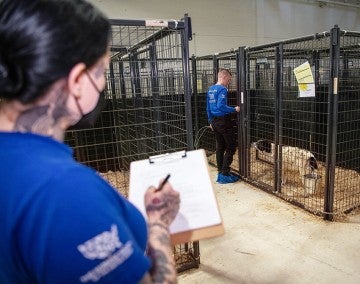
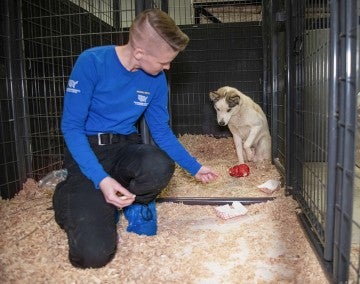
In another section, animal rescue responder Michelle Clancy performs the same kind of careful dance, entering kennels on one side and allowing worried dogs to move to the other. She offers a dog named Paco a meatball from her hand, but he won’t take it. She leaves the meatball behind, and he gingerly eats it. “If we force them to go at a pace we want, that’s just going to make it horrible for them. We’re taking it slow, and that’s when we see their real personality come out.”
Several days later, some of the San Miguel dogs are starting to anticipate mealtimes, coming up to the front of their kennels and wagging their tails. Vivienne Miller, the team’s behavior and enrichment specialist, decides to give the first behavioral assessments to eight dogs—the least terrified of the group. “We’re not starting from zero,” Miller says. “They are more relaxed now, sharing space with us.”
Miller uses a spectrum of fear, anxiety and stress (see below) to rate dogs on a scale of zero (green, relaxed) to four (red, flight/freeze/fret) and five (red, fight/aggression). This is the first time anyone has entered the eight dogs’ kennels other than to bring food, water and treats or to clean, because the dogs haven’t wanted human contact. “We’ve spent the last two weeks trying to communicate, ‘This is your safe space,’ ” says Miller.
The spectrum of fear, anxiety and stress
To determine whether dogs are relaxed enough to approach or handle and to follow their progress, the Animal Rescue Team uses this chart (abbreviated) to rate fear levels.
SEVERE
FAS 5 Offensive aggression: Lunging, ears forward, tail up, showing only the front teeth.
Defensive aggression: Dilated pupils, direct eye contact, showing all teeth. Hair may be up on the back and rump.
FAS 4 Flight: Ears back, tail tucked, trying to escape.
Freeze/fret: Immobile, dilated pupils, heavier breathing, trembling, ears back, tail tucked, hunched.
MODERATE
FAS 3 Turning head away, may refuse treats for brief moments or take treats roughly.
FAS 2 Ears slightly back or to the side, tail down but not necessarily completely tucked. Slow movements or unable to settle.
MILD
FAS 1 Alert/excited/anxious: Tail up, looking directly, mouth closed, eyes intense.
FAS 0 Neutral: Ears lowered, not perked forward, soft brow and eyes.
Friendly greeting: Slow back-and-forth tail and butt wag, ears just slightly back, relaxed brow and eyes.
Source: Fear Free Happy Homes
The first dog, Chester, carries three long scars on his nose. As Katie DeMent, senior manager of animal care, approaches his kennel, Chester stands but does not look at her. She squats and backs into his half of the kennel, not making eye contact. He sniffs her pocket, which holds treats, and looks around. DeMent slips him a treat. Chester yawns and goes to lie in the corner. DeMent holds out her hand, but he looks away. She tries again, twice, but each time he turns toward her then away. “I could reach for him, but …,” says DeMent. “I agree with you,” says Miller. “He’s obviously overwhelmed, but he’s doing a really good job.”
DeMent doesn’t try to pet Chester again but moves on to the next step in the assessment. Talking in a friendly, calming voice, she stretches out her hand and loops a leash over Chester’s neck. “Are you going to move?” Chester takes a few steps forward before returning to the corner. As DeMent withdraws, Chester slides into the other half of the kennel, where she has left a chicken treat. “He didn’t panic,” DeMent says. Miller rates Chester a three.
In teaching dogs to trust people, members of the rescue team must also trust. They must believe that their work will have an effect, even when progress is incredibly slow and the dogs appear far from accepting a pet or walking on a leash, let alone adapting to human homes.
It helps to understand what trauma does to dogs, say Audra Houghton, director of operations for the rescue team, and Dr. Sheila Segurson, director of research for Maddie’s Fund, who give talks on trauma-informed sheltering. An animal who has suffered trauma might react to stimuli in an exaggerated way, Segurson says.
When Houghton adopted a Tosa Inu named Gregg, whom Humane Society International rescued from a Korean dog meat farm, the big, laid-back dog seemed to be settling in well. Then one day a rolling pin accidentally fell with a clatter on the tile kitchen floor. Gregg panicked, crashing into the oven and falling to the floor. After that, he refused to go into the kitchen. Houghton moved his food to another room.
Want more content like this?
This was written and produced by the team behind All Animals, our award-winning magazine. Each issue is packed with inspiring stories about how we are changing the world for animals together.
Learn MoreSubscribe
